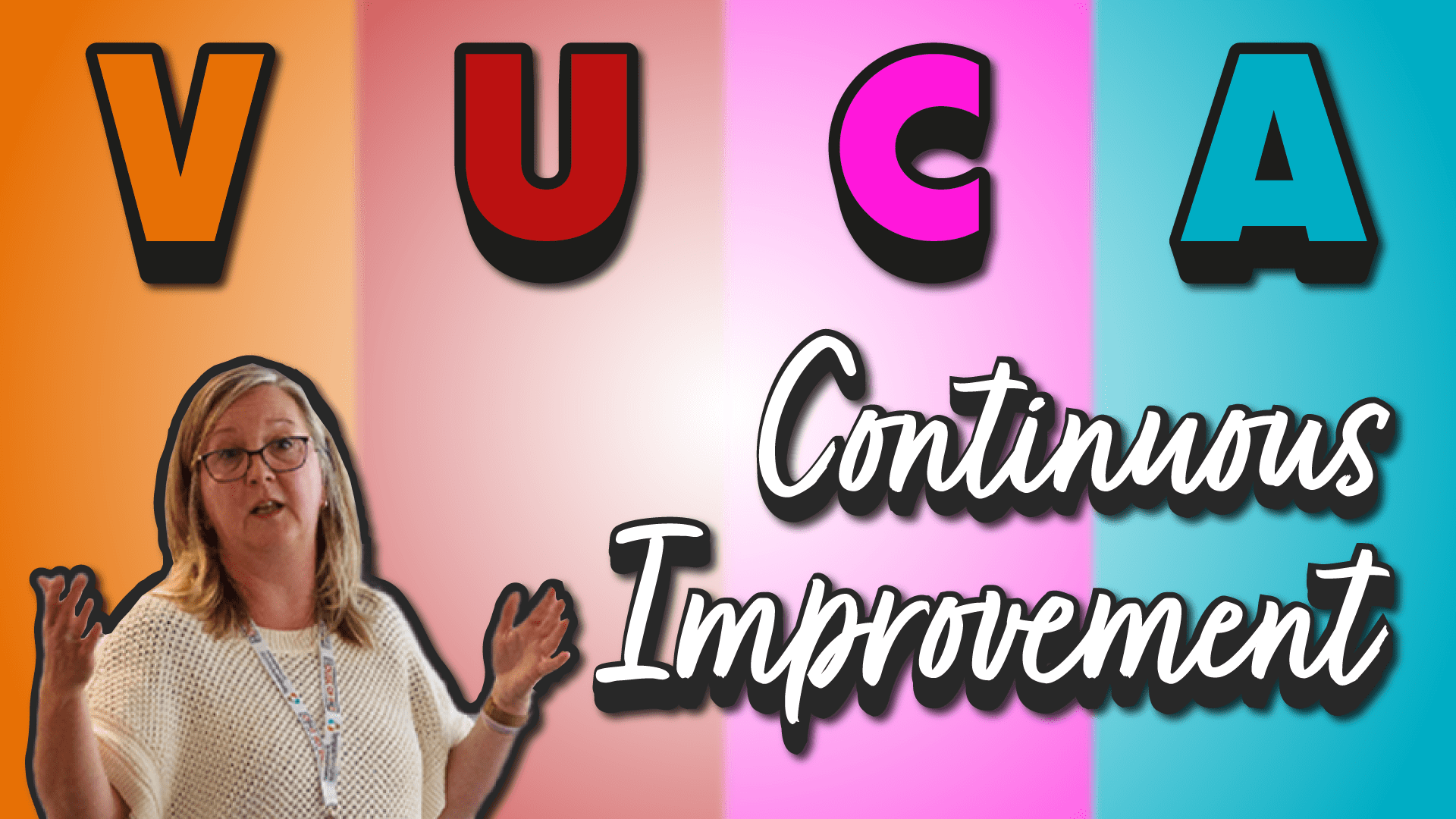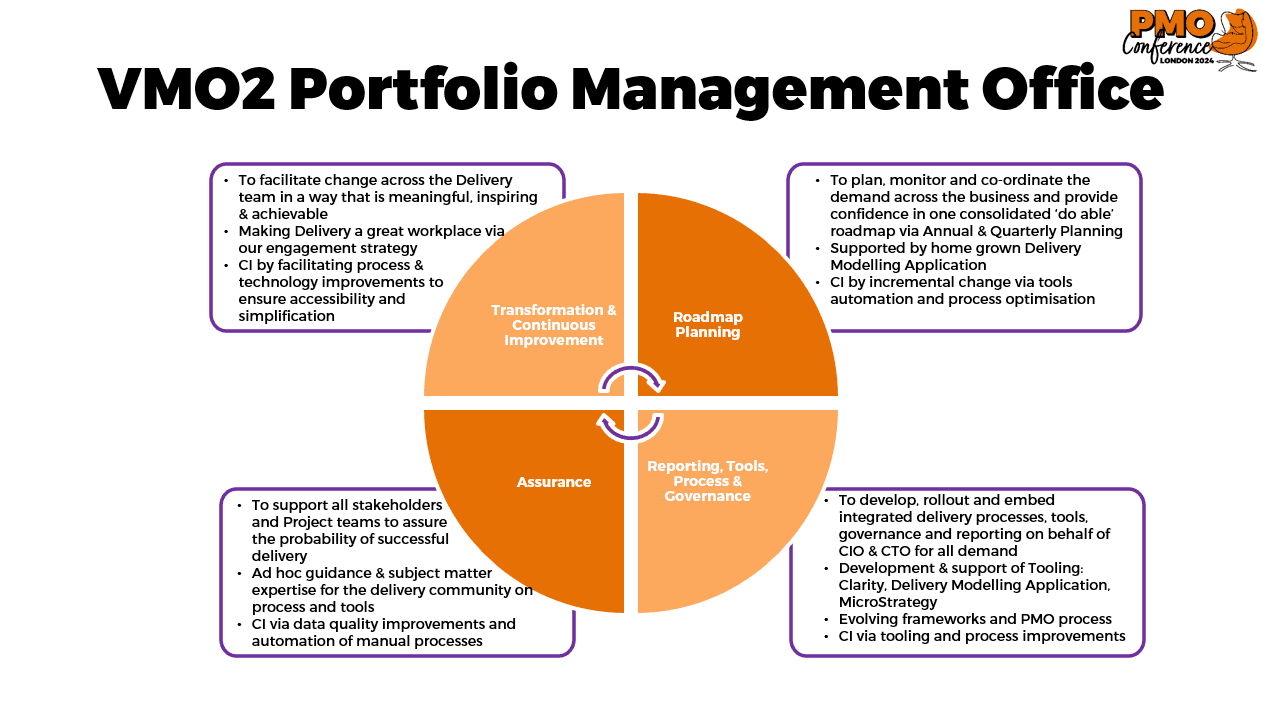Watch back all our PMO Conference sessions
Continuous Improvement in a VUCA Environment
In this session, we delve into the role of the PMO in driving Continuous Improvement within P3M (Project, Programme, and Portfolio Management) delivery organisations, particularly in a VUCA environment. It will explore how the PMO can champion and orchestrate change initiatives that adapt to volatile, uncertain, complex, and ambiguous conditions, ensuring that projects not only align with strategic goals but also embrace adaptive and iterative improvements.
The session highlights practical tools and techniques that have proven effective and discusses the optimal timing for implementing these changes to maximise impact. You will gain a clear understanding of how a proactive PMO can serve as a catalyst for improvements and organisational resilience.
The session was recorded at the PMO Conference in London 2024 and features Emily Hislop, Transformation & Continuous Improvement Manager from Virgin Media O2.
Recorded Session
Presentation Deck
Download the DeckKey Insights
 In early March 2020, Emily Hislop found herself launching a series of continuous improvement initiatives within her team. The world, however, had other plans. Just days after their first face-to-face meeting of the year, the UK went into lockdown. Suddenly, the focus shifted from long-term improvement projects to immediate survival: setting up home offices, figuring out food shopping, and managing homeschooling.
In early March 2020, Emily Hislop found herself launching a series of continuous improvement initiatives within her team. The world, however, had other plans. Just days after their first face-to-face meeting of the year, the UK went into lockdown. Suddenly, the focus shifted from long-term improvement projects to immediate survival: setting up home offices, figuring out food shopping, and managing homeschooling.
It wasn’t the time to push traditional continuous improvement; instead, it was about quickly adapting to whatever the team needed to keep things running. This rapid pivot and emphasis on team support and communication became a cornerstone of their strategy, demonstrating how even in the face of uncertainty, adapting to change is essential for survival and growth.
What is VUCA?
 VUCA stands for Volatile, Uncertain, Complex, and Ambiguous. It is a concept that originated in the military but has since been adopted by the business world to describe the challenging conditions that organizations face today. Here’s a breakdown of what each component means:
VUCA stands for Volatile, Uncertain, Complex, and Ambiguous. It is a concept that originated in the military but has since been adopted by the business world to describe the challenging conditions that organizations face today. Here’s a breakdown of what each component means:
- Volatility: Refers to the speed and unpredictability of change. In a volatile environment, things can change rapidly and in unexpected ways. This could be due to market fluctuations, technological advancements, or sudden shifts in consumer behaviour.
- Uncertainty: Involves a lack of predictability and an inability to foresee future events. Uncertainty means that even if you have lots of data, you can’t be sure what will happen next or how certain factors will interact to impact your organisation.
- Complexity: Refers to the many interconnected variables and factors that can influence a situation. In a complex environment, there are multiple elements at play, and the relationships between them are often difficult to understand. This complexity can make it challenging to identify cause-and-effect relationships.
- Ambiguity: Deals with a lack of clarity and the existence of multiple interpretations. Ambiguity arises when information is incomplete or contradictory, making it difficult to draw clear conclusions. This could involve unclear guidelines, uncertain outcomes, or vague objectives.
The Portfolio Management Office
 The Portfolio Management Office at VMO2 is a crucial entity supporting continuous improvement, governance, alignment, communication, stakeholder engagement, and adaptability. Its role is not just to oversee projects and programmes but to ensure that these efforts are strategically aligned with the broader organisational goals, thereby driving value and improving overall organisational effectiveness.
The Portfolio Management Office at VMO2 is a crucial entity supporting continuous improvement, governance, alignment, communication, stakeholder engagement, and adaptability. Its role is not just to oversee projects and programmes but to ensure that these efforts are strategically aligned with the broader organisational goals, thereby driving value and improving overall organisational effectiveness.
The Portfolio Management Office supports four uber portfolios (Consumer, Technology, B2B and CTO) plus non-project change, and a recent addition of the Digital delivery team.
Roadmap Planning
Roadmap planning was highlighted as an essential component of the continuous improvement initiatives within the organisation. By feeding information into the roadmap planning, teams could better align their efforts with strategic objectives and timelines. This integration ensured that all relevant departments and teams were aware of upcoming tasks and deadlines, contributing to a smoother project execution process.
Reporting, Tools, Processes and Governance
Part of the continuous improvement initiatives involved tackling issues with reporting. Specifically, the focus was on reducing unnecessary processes and eliminating the duplication of reports. The team implemented a structured approach to lessons learned reviews. These reviews were conducted monthly and the learnings were driven back into the change board to inform future decisions. This reporting mechanism helped ensure that insights from past projects were systematically captured and applied to improve future project outcomes.
One of the continuous improvement work streams involved the development and use of KPI (Key Performance Indicator) dashboards. These dashboards were used to monitor critical metrics, such as uptime on IT platforms. The dashboards provided real-time data that could trigger alerts when performance deviated from expected standards, enabling proactive management of potential issues.
Continuous improvement initiatives targeted several processes within the organisation. Examples included enhancing onboarding processes, conducting quality assurance clinics, and standardising project management practices. The focus was on making processes more efficient and ensuring consistency across different teams and projects.
A key governance-related initiative was the introduction of a technology governance board. This board provided a formal structure for IT platform teams to have a voice in project-related decisions. It allowed teams to challenge projects that could negatively impact their operations, ensuring that governance was not just top-down but included input from those directly affected by decisions.
Assurance
Assurance was a recurring theme in VMO2’s governance and continuous improvement approach. By focusing on lessons learned, quality assurance clinics, and transparent reporting, the organisation ensured that its projects and programmes were aligned with best practices and high standards. These efforts contributed to building a culture of accountability, continuous improvement, and reliability across the organisation.
Quality assurance clinics were set up focusing on quality, which helped standardise processes and ensure that project deliverables met the required standards. These clinics served as platforms for discussing best practices, troubleshooting quality issues, and providing guidance on maintaining high-quality outputs.
Transformation & Continuous Improvement
VMO2 viewed transformation as a critical component of its continuous improvement efforts. Specific work streams were dedicated to transforming various aspects of the organisation. For example, there was collaboration with agile teams to create training programs that would enhance employees’ knowledge of agile methodologies. This focus on agile transformation helped them become more adaptable and responsive to change, which is essential in a VUCA (Volatile, Uncertain, Complex, Ambiguous) environment.
Transformation was also seen as a way to align the organisation’s processes and practices with its strategic objectives. By incorporating continuous improvement into transformation efforts, the organisation ensured that changes were not only reactive but also proactive, supporting long-term strategic goals. This alignment helped maintain focus on value creation and organisational resilience.
How the PMO is Managing Continuous Improvements
 At present they have four different aspects to their approach, this is currently:
At present they have four different aspects to their approach, this is currently:
- Engage with the teams via various forums – and take notice of employee engagement survey feedback.
- Drive feedback through the Product Owner Group (POG) – which is a forum with representatives from each portfolio, the PMO, the DVF/Trade Union representatives.
- From there, ideas and requests go to the Change Board to be sized before being feedbacked to POG for further prioritisation if needed.
- Incremental changes are delivered on a monthly basis, with larger change cycles every 6 months.
Engaged Teams
 In Emily’s opinion, “the single most important thing with Continuous Improvement is to have an engaged team. It’s critical to landing any improvement. AI can write processes but we as people need to buy in – it really boils down to the Simon Sinek quote:
In Emily’s opinion, “the single most important thing with Continuous Improvement is to have an engaged team. It’s critical to landing any improvement. AI can write processes but we as people need to buy in – it really boils down to the Simon Sinek quote:
“Happy employees ensure happy customers. And happy customers ensure happy shareholders – in that order.”
Tools, Techniques and Approaches
 There’s a multitude of tools and techniques out there. Understanding your challenge and how your stakeholders consume information is vital to picking the right one. Some stakeholders prefer data – so you’ll have to measure before & after to prove your improvement. Some stakeholders measure improvements by the softer skills – “I was getting loads of noise around this process, but not anymore.”
There’s a multitude of tools and techniques out there. Understanding your challenge and how your stakeholders consume information is vital to picking the right one. Some stakeholders prefer data – so you’ll have to measure before & after to prove your improvement. Some stakeholders measure improvements by the softer skills – “I was getting loads of noise around this process, but not anymore.”
In terms of approaches, Lean Six Sigma was crucial, as is understanding the theory of constraints.
Lean Six Sigma is a “methodology combining Lean and Six Sigma principles to improve business processes, enhance efficiency, and reduce waste. It focuses on improving quality and efficiency by systematically removing waste and reducing variation.” [More information]. The theory of constraints (TOC) is a management philosophy that “focuses on identifying and managing the bottlenecks or constraints that limit the performance and efficiency of a system or process.” [More Information]
Emily’s opinion is that each approach have their merits, so pick a methodology, but understand that the engagement of the team is crucial – the more they feel invested in the team, the more passion they will have for the work.
Final Words
Can you run a continuous improvement workstream in a VUCA organisation (& world)? Yes, and you must because the organisation needs to meet the VUCA challenges. What you’ll need to consider is the right time and the priority order – it may not be the most obvious. Delivering in a command-and-control method doesn’t work in an organisation and world which are VUCA, this is our new norm – our reality so you can’t wait for stability – you need to keep flexing and adapting, keep continually improving.
Actionable Insights
1. Prioritize Team Engagement and Support
- Emily Hislop’s experience highlights that team engagement and communication became the cornerstone of success during uncertain times. PMOs should focus on supporting their teams first, ensuring they are well-equipped to adapt to changes. This might involve facilitating flexible working environments or providing tools and resources for remote collaboration.
- Practical Tip: Consider running regular forums or pulse surveys to keep a check on team morale and address concerns, just as Emily’s team did by driving feedback through their Product Owner Group (POG). Engaged teams are key to continuous improvement.
2. Adopt Agile Approaches to Continuous Improvement
- Continuous improvement doesn’t stop during a crisis; it pivots. In a VUCA world, rigid long-term plans need to be adapted. Emily’s team quickly shifted from long-term improvement initiatives to smaller, more incremental changes. PMOs should embrace agile methodologies to remain flexible and responsive to immediate needs, while still pursuing long-term goals in smaller cycles.
- Practical Tip: Use agile ceremonies like retrospectives and sprint reviews to regularly assess what’s working and where improvements are needed. This keeps the team focused on short-term goals while maintaining alignment with strategic objectives.
3. Implement Structured Reporting and Governance
- The introduction of governance mechanisms, such as the technology governance board in Emily’s scenario, shows how formal structures can empower teams to have a voice in project decisions. PMOs should ensure that governance structures allow for both top-down and bottom-up communication, ensuring that the people affected by decisions are involved in them.
- Practical Tip: Streamline governance to avoid unnecessary bureaucracy, focusing on what adds value. For example, eliminate redundant reports and unnecessary processes to maintain efficiency without stifling innovation.
4. Leverage KPI Dashboards for Proactive Management
- The introduction of KPI dashboards in VMO2 enabled real-time monitoring and quicker responses to deviations in performance. PMO professionals should utilise real-time data dashboards to monitor critical metrics and proactively address issues before they escalate.
- Practical Tip: Ensure KPIs are aligned with both operational and strategic goals, providing clear visibility on performance that can trigger immediate corrective actions.
5. Engage in Active Knowledge Sharing
- The importance of capturing lessons learned and feeding them back into future decision-making processes was underscored by Emily’s structured lessons-learned reviews. PMOs should ensure that lessons learned from each project are systematically captured and shared to prevent repeated mistakes and to build organisational knowledge.
- Practical Tip: Regularly hold “lessons learned” sessions post-project or monthly, and ensure that these insights are effectively communicated back to the relevant teams and leadership.
6. Adapt Governance and Processes in a VUCA Environment
- The VUCA concept highlights the importance of adapting governance frameworks to the volatile and unpredictable environment we face today. Traditional command-and-control methods may not work in such settings. PMOs need to flex governance based on the complexity and volatility of the projects they oversee, applying lighter governance where agility is needed and more formal structures where stability is key.
- Practical Tip: Use a flexible governance approach, right-sizing governance for each project depending on its complexity and risk level.
7. Focus on Business Outcomes, Not Just Process
- A key takeaway from the continuous improvement process is that it’s not enough to have streamlined processes. The focus should always be on the impact those processes have on the business. PMOs should measure success not just by following the process but by ensuring that projects deliver real business outcomes that align with strategic objectives.
- Practical Tip: Tie project outcomes to business value and communicate this clearly to stakeholders, ensuring that everyone understands how each project supports broader business goals.
By adopting these actions, PMO professionals can enhance their adaptability and resilience, leading to better performance and greater alignment with their organisation’s strategic goals, even in uncertain times.



